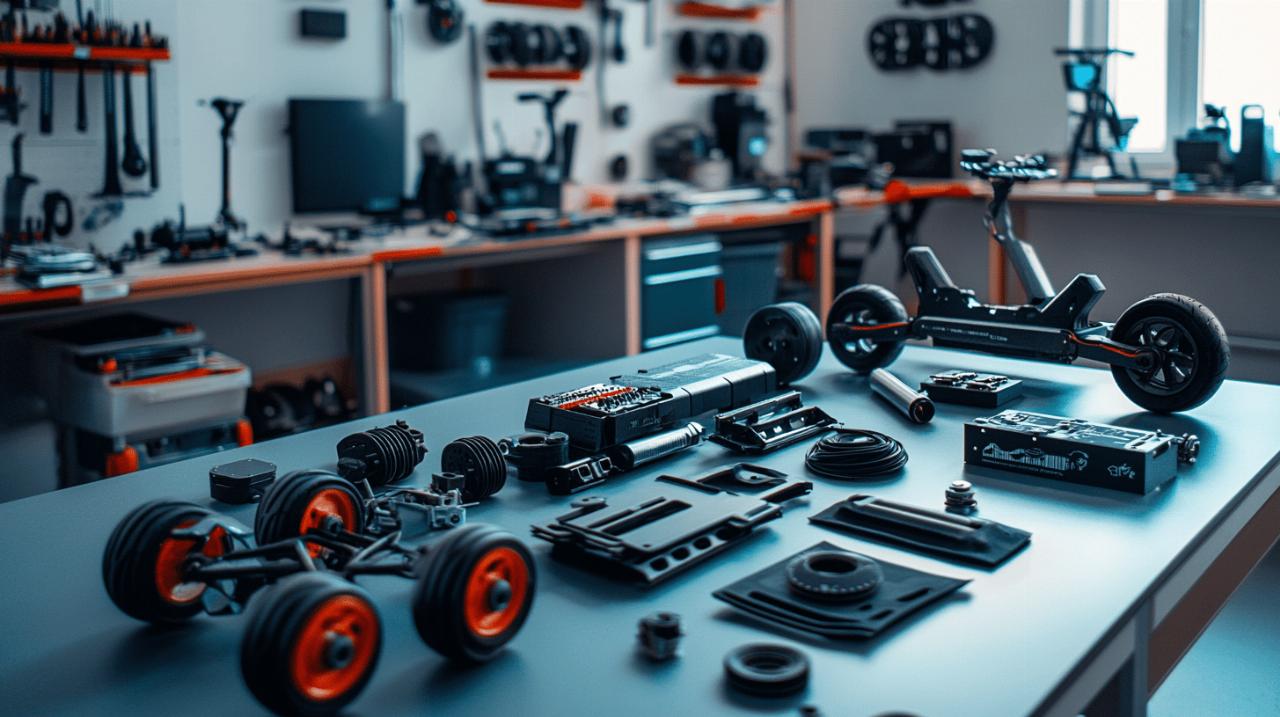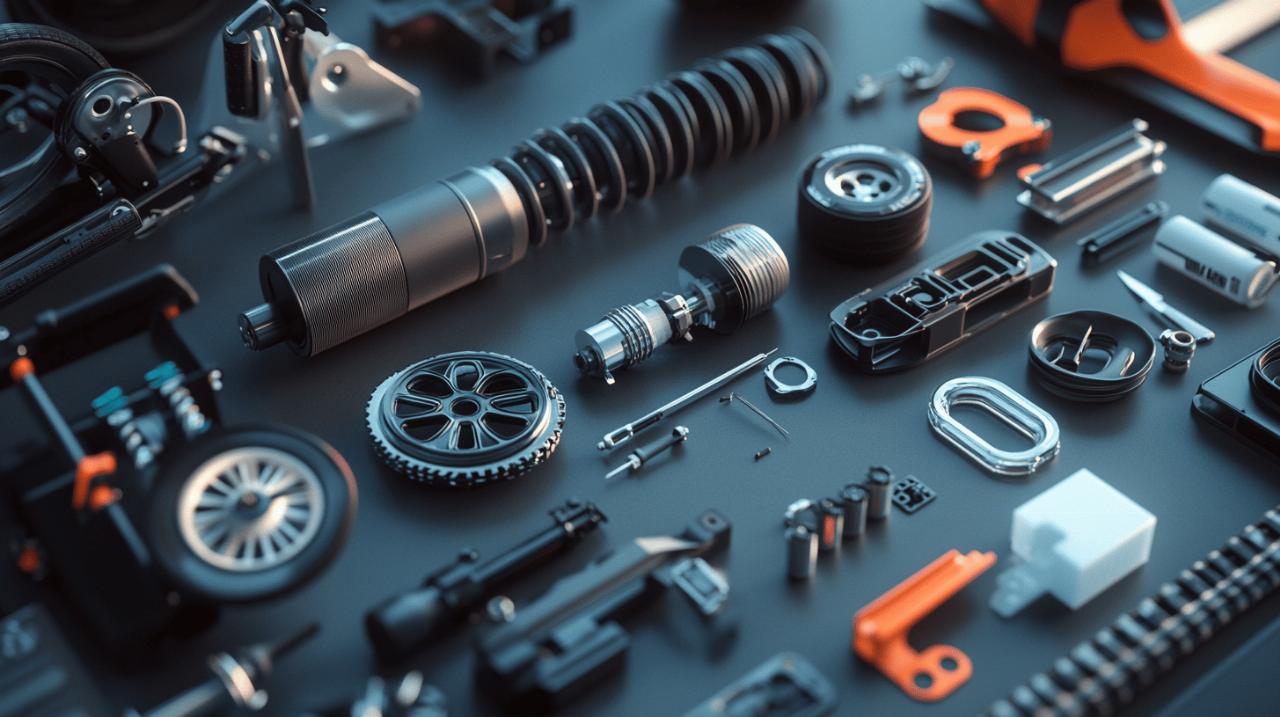Electric scooter maintenance plays a vital role in rider safety, with the brake system being one of the most critical components requiring regular attention and quality spare parts. Proper brake maintenance ensures optimal stopping power and reliable performance during daily commutes.
Understanding electric scooter brake components
Modern electric scooters come equipped with sophisticated braking systems, requiring specific spare parts for maintenance and repairs. These components work together to provide reliable stopping power across various speed ranges, from 20 km/h to 80 km/h.
Basic brake system structure
The brake system comprises several essential parts, including brake pads, calipers, rotors, and control mechanisms. These components are available for numerous brands like XIAOMI, NINEBOT, APOLLO, and DUALTRON, ensuring compatibility with most popular electric scooter models.
Different types of brake mechanisms
Electric scooters utilize various braking systems, from basic rear foot brakes to advanced dual mechanical setups. Premium models from manufacturers like VSETT and KAABO often feature multiple braking mechanisms, enhancing safety at higher speeds reaching up to 70-80 km/h.
Essential brake replacement parts
Maintaining a reliable brake system is crucial for electric scooter safety. Quality brake components ensure optimal stopping power and control during your rides. Proper maintenance and timely replacement of worn parts protect both the rider and the scooter.
Brake pads and discs maintenance
Brake pads require regular inspection and replacement to maintain optimal braking performance. Signs of wear include reduced stopping power and unusual noises during braking. Most major brands like XIAOMI, NINEBOT, and DUALTRON offer compatible brake pads. The disc surface should remain smooth and free from deep grooves or warping. A well-maintained disc brake system provides consistent performance across various riding conditions.
Brake cables and hydraulic system elements
The brake system's reliability depends on properly functioning cables and hydraulic components. Brake cables must be regularly inspected for fraying or damage. Hydraulic brake systems need periodic fluid checks and bleeding to maintain optimal pressure. Many brands like VSETT, APOLLO, and KAABO provide comprehensive brake system components. Regular maintenance of these elements ensures responsive braking and rider safety.
Selecting quality brake components
Brake system maintenance stands as a crucial aspect of electric scooter safety. When upgrading or replacing brake components, selecting the right parts ensures optimal performance and rider protection. The market offers various brake parts compatible with major brands like XIAOMI, NINEBOT, APOLLO, DUALTRON, and VSETT.
Material durability considerations
The longevity of brake components relies heavily on material quality. Electric scooters operating at speeds ranging from 20 km/h to 80 km/h require robust brake systems that can withstand regular use. Premium brake parts utilize weather-resistant materials suitable for various riding conditions, offering reliable performance across different terrains and maintaining effectiveness during both short urban commutes and extended rides up to 180km.
Brand compatibility factors
Each electric scooter brand implements specific brake system designs. When selecting replacement parts, cross-compatibility between manufacturers like KAABO, NAMI, or VSETT must be verified. The growing e-mobility market in Switzerland demands precise component matching, especially for models designed for varying power outputs from 350W to 2800W. Riders benefit from the extensive 24-month warranty coverage, ensuring peace of mind with their brake system investments.
Installation and maintenance guidelines
A well-maintained brake system safeguards riders during their electric scooter journeys. Proper installation and routine maintenance of brake components ensure optimal performance and longevity of your electric mobility device.
Step-by-step brake system assembly
Start by gathering all necessary brake components, including cables, calipers, and pads. Mount the brake calipers securely to the frame, aligning them perfectly with the disc rotor. Install fresh brake pads, ensuring even spacing on both sides. Connect the brake cables, adjusting tension for responsive braking action. Test the system thoroughly while stationary before taking your first ride.
Regular inspection routines
Make brake system checks part of your weekly maintenance schedule. Examine brake pads for wear and replace when thickness drops below manufacturer specifications. Check brake cables for fraying or damage. Verify proper caliper alignment and adjust if needed. Clean brake components regularly to remove dirt and debris. Testing brake responsiveness before each ride maximizes safety during urban commutes.
Safety testing and performance standards
 Electric scooter brake systems undergo rigorous testing to ensure rider safety and reliability. Modern brake components need to meet specific quality benchmarks before they can be installed on vehicles reaching speeds of up to 80 km/h. Quality spare parts from recognized brands like APOLLO, DUALTRON, and VSETT incorporate these safety standards into their design.
Electric scooter brake systems undergo rigorous testing to ensure rider safety and reliability. Modern brake components need to meet specific quality benchmarks before they can be installed on vehicles reaching speeds of up to 80 km/h. Quality spare parts from recognized brands like APOLLO, DUALTRON, and VSETT incorporate these safety standards into their design.
Brake system certification requirements
Brake components must align with Swiss transportation regulations, particularly for models approved for speeds of 20-25 km/h. The certification process evaluates critical elements such as brake pads, rotors, and hydraulic systems. Manufacturers like XIAOMI, NINEBOT, and KAABO provide certified replacement parts that maintain the original safety specifications of their electric scooters.
Performance testing protocols
Brake system testing focuses on durability across varied terrain and weather conditions. Tests evaluate stopping power at different speeds, from urban-friendly 20 km/h models to high-performance scooters capable of 70-80 km/h. Leading brands implement strict quality control measures for spare parts, ensuring consistent performance throughout the 24-month warranty period. These protocols verify brake system reliability across diverse operating conditions, from city commuting to all-terrain use.
Purchasing guidelines for brake parts
Selecting the right brake components for your electric scooter is crucial for maintaining optimal safety during your urban commutes. Several leading brands like XIAOMI, NINEBOT, APOLLO, and DUALTRON offer reliable brake parts designed for peak performance.
Budget and quality balance
When investing in brake system parts, price considerations must align with quality standards. Premium brake components from respected manufacturers like KAABO and VSETT might command higher prices but deliver superior durability. A strategic approach involves evaluating your usage patterns and selecting parts that match your specific model's requirements, whether it's for daily commuting or occasional rides.
Verified supplier selection
Choosing authorized dealers guarantees authentic spare parts and proper warranty coverage. Many suppliers offer a 24-month warranty on brake components, ensuring long-term reliability. Working with established stores in locations like Bâle, Lausanne, Wettingen, and Zürich provides local support and expertise. Free shipping options for orders above CHF 100 in Switzerland make authorized parts more accessible.
Storage and Maintenance of Brake Components
Proper storage and maintenance of brake system components for electric scooters ensure optimal performance and longevity of your urban mobility device. Most spare parts, including those for brands like XIAOMI, NINEBOT, and DUALTRON, require specific storage conditions to maintain their functionality.
Optimal storage conditions for brake parts
Store brake components in a clean, dry environment away from direct sunlight. The storage area must maintain steady temperature levels to prevent material degradation. When storing brake parts for electric scooters capable of speeds between 20-80 km/h, organize components by model specifications to avoid mixing parts from different systems.
Long-term preservation techniques
Apply protective coatings to metal brake components to prevent corrosion during extended storage periods. Keep brake pads sealed in their original packaging until needed. For electric scooters with varying power ratings from 350W to 2800W, label and catalogue stored parts systematically. Maintain an inventory system to track component age and condition, ensuring parts remain within their usable lifespan. Regular inspection of stored components helps identify any signs of deterioration before installation.
Professional Tools and Equipment for Brake Maintenance
Maintaining the brake system of your electric scooter requires specific tools and equipment to ensure optimal safety and performance. Proper maintenance of braking components is crucial for riders who want to maximize their urban mobility experience across varying speeds from 20 km/h to 80 km/h.
Required specialized brake tools
A comprehensive set of specialized brake tools is vital for maintaining various electric scooter models including APOLLO, DUALTRON, and VSETT. The essential toolkit should include brake pad gauges, cable tensioners, and adjustment wrenches designed specifically for scooter brake systems. These tools enable precise maintenance of brake components, ensuring reliable stopping power for models ranging from basic 350W systems to powerful 2800W variants.
Diagnostic equipment for brake systems
Modern electric scooters require specific diagnostic equipment to maintain their brake systems effectively. Digital brake testers help measure brake response and performance across various speeds and conditions. This equipment is particularly valuable for high-performance models like NAMI and KAABO, which can reach speeds up to 70-80 km/h and require regular brake system checks to maintain safety standards. Regular diagnostic testing helps identify potential issues before they become serious safety concerns.






Comments are closed.